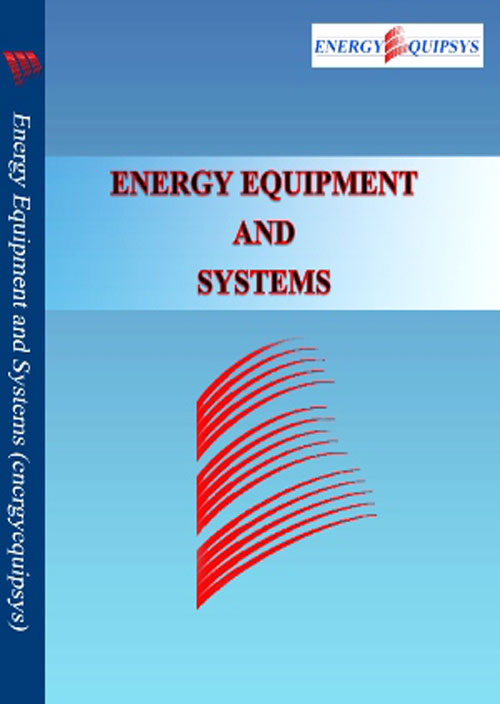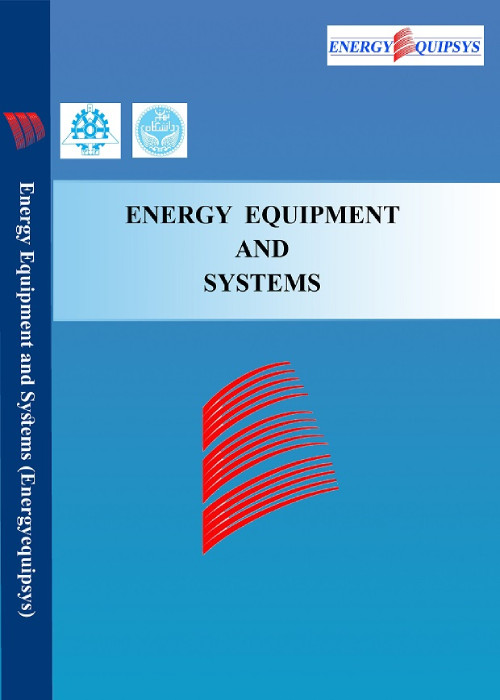فهرست مطالب

Energy Equipment and Systems
Volume:9 Issue: 3, Summer 2021
- تاریخ انتشار: 1400/06/31
- تعداد عناوین: 6
-
-
Pages 209-227
The positive effect of self-sustained passive oscillations of two flexible vortex generators (VGs) in the naturally air flow of a solar air heater (SAH) is examined in this paper. Two VGs are attached on opposite walls of 2-D channel of the heater, where the turbulent air flows because of the buoyancy effect. The set of continuity, momentum and energy equations for free convection flow and also the equation of motion for elastic solid structure considering a two-way strongly-coupled fluid-solid interaction (FSI) are solved in transient condition by the finite element method (FEM). Numerical result shows higher performance for SAH with two VGs in comparison with a single winglet and also with clean SAH. Although, the airflow rate decreases about 16% in SAH with two VGs because of the blockage effect of winglets, but 35% improvement in bulk temperature increase along the SAH is seen in comparison to the single VG solar heater. The applied numerical simulation has been validated against experimental and theoretical results of literature and good agreement was found.
Keywords: Natural SAH, Turbulent flow, Multiple VG, transient -
Pages 229-248In the current study, a new integrated system is provided to prevent waste energy and reduce power consumption. This system consists of a cascade refrigeration system (for cooling) and an Organic Rankine cycle(ORC) (for power generation). These two cycles are combined through a heat exchanger. In fact, this heat exchanger acts as a condenser for the cascade refrigeration cycle and evaporator for ORC. The waste heat of the cascade refrigeration cycle is used to handle the ORC. In this way, a part of the power consumption of the cascade refrigeration cycle is satisfied by ORC. Thermodynamic simulation of the proposed system is carried out via Engineering Equation Solver(EES) software. A parametric study is done to evaluate the effects of the operational parameters on the performance of the integrated system. In addition, different working fluids are used in cascade refrigeration and ORC cycles. The results showed that by using the working fluids of R245fa, R717, and R141b in order in the low-temperature refrigeration cycle, high-temperature refrigeration cycle and ORC, one can produce cooling at -50 ° C and also reduce the power consumption up to 48.69% in the cascade refrigeration cycle.Keywords: thermodynamic analysis, Scramjet, Hydrogen, Multi-Expansion, M-OCC, PEM Electrolyzer
-
Pages 249-260In this research paper, a comprehensive thermodynamic model of a LAES system is carried out. Exergy analysis as a potential tool to determine the location and magnitude of losses is applied. The proposed system is comprised of two sub-systems, one is used for air liquefaction which is considered as energy storage. This step is called the charging process. The liquid air is then stored in a cryo-tank. The liquid air is then directed to a series of turbo-expanders for the discharge process. For the system simulation, a code is developed which links the Refprop software to Matlab software where thermophysical properties are obtained. In order to have a better insight of the analyses, a parametric study is performed. The effect of several main parameters (i.e., the main pressure entering the cold box, compressor inlet temperature and the first compressor pressure) of the storage cycle on efficiency and cost are investigated. The results indicate that the outlet temperature of the final turbine is limited to the temperature that can enter the evaporator. This constrains limits the inlet temperature to the turbine, which reduces efficiency. In addition, the storage cycle pressure is low. An increase in the main pressure to the cold box can be useful in increasing efficiency. Besides, reducing the inlet temperature to the compressors can increase performance.Keywords: Liquid Air Energy Storage, Exergy Analysis, Cost Assessment, Storage
-
Pages 261-278
In this research, an intercooler of three-stage centrifugal compressor is investigated in order to decrease energy consumption. Due to the lack of comprehensive studies about optimization of efficiency and cost for the finned shell and tube intercoolers, with using non-dominated sorting genetic algorithm (NSGA-II), the efficiency of shell and tube heat exchanger with radial fin (intercooler) is studied to improve the performance of multi-stage compressor. The total cost and efficiency of an intercooler are selected as two objective functions. Also, some main decision variables, such as tube arrangement, mass flow rate on the tube and shell sides, the diameter of tubes, rate of tube pitch as well as inlet temperatures of tube and shell are considered. The heat transfer coefficients and the pressure drop of the shell-side are calculated based on Delaware modified method. The variation of efficiency based on the tube length, tubes number, baffle spacing ratio and tube pitch rate are investigated. The results show that using NSGA-II, the efficiency improves up to 96 %. Also, the best fins number per inch length of the tube is 26 which leads to the highest efficiency value. Results show that the tube shape has no effect on the efficiency and by increasing tube pitch rate the total costs decreases. The optimization results with NSGA-II is compared with the PSO method and it shows the accuracy of the genetic algorithm. Also, the thermal modeling is validated with another study and the maximum difference is estimated about 2%.
Keywords: Shell, Tube Heat exchanger, Intercooler, Three-stage centrifugal compressor, Optimization, Genetic algorithm -
Pages 279-289Solar Energy is considered the cleanest and the most accessible energy source in the world. Its application is also one of the best electrification and energy transmission methods than other energy transmission models for outlying villages in terms of costs, transportation, maintenance, and similar factors. Accordingly, one of the critical studies on the context of exploitation of this energy is the possibility of establishing and identifying susceptive areas. In this study, the amount of solar energy entering the earth's surface and the number of cloudiness days were studied based on the studied area's meteorological data. Also, we designed and simulated solar photovoltaic power plants through the Meteorological Data on Virtual model. The solar analyzer function in the ArcGIS commercial closed environment was used to estimate the entering radiation to the earth's surface in the studied area. To study the number of cloudiness days has been used from the mentioned area's weather station data. The results showed that the solar analyzer function showed four months of the year available for full exploitation of these systems. The highest amount of radiation occurred after July. Optimal radiation conditions continue until November. In some days of the remaining months, this energy has been confronted with limitations. Nine villages were identified with the highest solar power utilization in the present study. Villages include the following: Kuran, Hurseen, Bavan, Barduk, Betic, Mareush, Jolfan, Sin Abad and Gudel.Keywords: Solar Energy, Villages, Photovoltaic Power Plants, ArcGIS, Solar Analyzer Function
-
Pages 291-305Technical and executive problems available in the Iranian utility grid inhibit utilizing power at all times. Therefore, considering the importance of the applications of hospitals and medical service centers they should either use auxiliary and backup devices such as diesel generators and UPS, or renewable hybrid power systems. To this end, this paper conducted 3E analysis (energy-economic-environmental analysis) in a medical clinic of Mashhad using HOMER software. The studied renewable hybrid system was an off-grid wind-solar system designed with a peak load of 5.3 kW to produce 19 kWh/day power. Adapting the data of a 20-year history of solar radiation and wind speed and use of the updated price of devices, updated price of fossil fuels and annual interest rate consistent with current economic conditions are other advantages of this work. The investigation of results indicates the superiority of solar potential to wind potential in the studied region. In addition, the configuration of the most economic scenario with minimum pollution emission was as follows: PV cells (4 kW), a diesel generator (4 kW), batteries (n=20) and inverter (4 kW). The minimum price for producing 1 kWh power is 0.721 $ and the minimum emitted CO2 is 1861 kg/year.Keywords: HOMER Software, Medical Tourism, Solar Energy, Wind Energy


